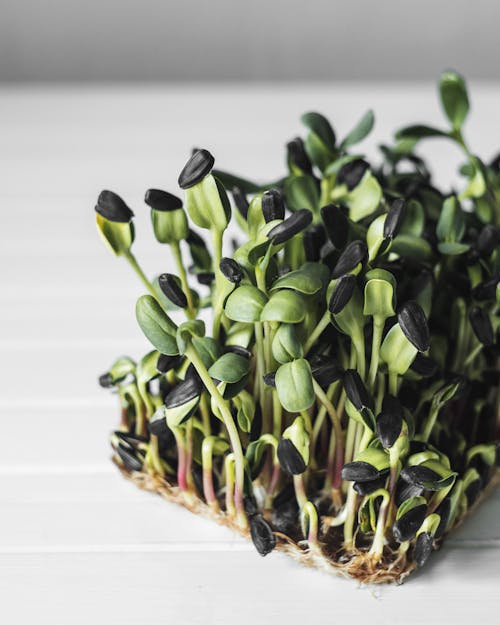Microgreens: What Are They?
Microgreens are long, delicate greens grown over a couple weeks and then harvested by cutting the young seedlings at the base. Microgreens have a higher concentration of nutrients compared to the larger variety.
Microgreens are NOT Sprouts:
Sprouts are seeds that can germinate quickly in a few days when soaked in water and left in the dark. The entire sprout can be eaten including the seedling, radicles, and what remains of the seed.
Microgreens VS. Sprouts: Which is safer?
Because the seeds for Sprouts are kept in warm, humid conditions, it is possible for bacteria to grow. This bacteria can cause the seed to allow for salmonella to lodge in the small cracks of the seed. This makes sprouts carry a higher risk of food poisoning. You can read more about sprouts and how to avoid food poisoning here.
Since Microgreens are grown for their tiny leaves above the soil, they carry a lower risk of food poisoning.
Microgreens: What is the Benefit?
Referred to as a "superfood," Microgreens are a source of fibers, essential minerals, vitamins, and antioxidant compounds including: vitamins A, E, C and K, calcium, magnesium, iron, selenium and zinc. According to Schnelker, quoted in the blog, Banner Health, "They also come packed with phytonutrients and antioxidants that protect against certain diseases, support your immune system and help your gut microbiome healthy."
Banner Health also illustrates:
* a cup of red cabbage microgreens has three times more folate than mature red cabbage
* a cup of arugula microgreens has 100% more vitamin A than arugula
* radish microgreens have double the amount of calcium and are higher in omega 3's than radishes
* compared to broccoli, broccoli microgreens have a higher content of the antioxidant sulforaphane, which helps lower fasting blood glucose levels and can protect against heart disease and cancer
Microgreens: Any Downsides?
Since you eat them in small quantities, you might not see a big different in health. They can be costly as a pound can cost $30 or more. It may be more practical to eat 2-3 cups of vegetables a day.
Microgreens: Are They For Me?
I think it comes down to personal choice. If you enjoy having readily available greens to throw on top of a sandwich or salad or meal, then you may want to explore other ways to use them.
If you enjoy growing your own food or herbs at home, then microgreens could be easy and readily available as they can grow on a window ledge, porch, balcony, or indoor garden.
Check out the following links for further reading:
Penn State Extension, Banner Health, Microgreens
Explore Recipe Options:
Urban Cultivator, Mighty Microgreen Recipes on Pinterest



